新人教版七年级英语下册unit3 How do you get to school教学设计
- 格式:doc
- 大小:3.11 MB
- 文档页数:4
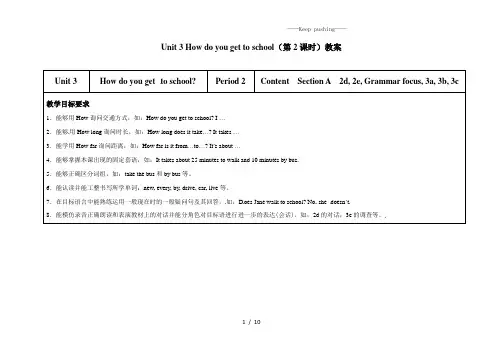
Unit 3 How do you get to school(第2课时)教案Unit 3How do you get to school?Period 2Content Section A 2d, 2e, Grammar focus, 3a, 3b, 3c教学目标要求1.能够用How询问交通方式,如:How do you get to school? I …2.能够用How long询问时长,如:How long does it take…? It takes …3.能学用How far询问距离,如:How far is it from…to…? It’s about …4.能够掌握本课出现的固定套语,如:It takes about 25 minutes to walk and 10 minutes by bus.5.能够正确区分词组,如:take the bus和by bus等。
6.能认读并能工整书写所学单词:new, every, by, drive, car, live等。
7.在目标语言中能熟练运用一般现在时的一般疑问句及其回答,如:Does Jane walk to school? No, she doesn’t.8.能模仿录音正确朗读和表演教材上的对话并能分角色对目标语进行进一步的表达(会话)。
如:2d的对话,3c的调查等。
1 / 10教学过程活动步骤教与学活动目的及其操作教学资源运用复习时间4 m 1复习已学目标语和导入谈论交通方式的话题Look at the picture. The girl is Mary. How does Mary get to school? (She takes the subway.)2仿照上述对话,组织Pair work复习活动OK. Now look at the pictures. Let’s do pair work, ask and answer the questions.学生双人活动,教师抽查几对学生导入时间2 m 3导入新课话题Look at the picture and now you are Tom, answer my questions.—How do you get to school?—How long does it take to get to school?—How far is it from the school to your home?4引入单元标题教师板书或课件显示:Unit 3 How do you get to school?2 / 102d 时间6 m 5齐读,然后分角色读Let’s read Conversations.6仿照上述对话,组织Pair workNow work in pairs, Student A is Jane, Student B is Tom. Use the information in 2b to make conversations.3 / 107拓展训练活动:哪位同学离校近,哪位离校远1.How do you get to school every day? Do you want to know how your classmates get to school? Whose home is near to school? And whose home is far from school? Please workwith your group and try to give me the answers.学生以小组为单元展开活动,询问彼此上学的途径、耗时及路程并填写右侧表格2.Now report your survey result. Others please write down the result.3.Discuss: How many students go to school by bus? How many go to school by bike? How many walk to school? How many go to school by other means?4 / 102e 时间6 m 8读图,了解对话情景—地点和谈论的话题First, look at the picture and read 2d.Then, answer:T: Who are the girls?S:(Lisa and Jane)T: Where are they?S: Near the school第一步:要求学生集体放声朗读对话,并从中发现学生的生词障碍;第二步:简短讲解、学习生词;9分角色练习对话以提升口语表达水平Role-play the conversation.Ask 1 or 2 pairs to show the conversation.5 / 1010语言探索发现,找出固定套语1.学生自主摘录出对话中新出现的固定套语;2.将自己的结论与周边同学合作对照,互通有无,修改完善;3.课堂师生讨论,确认答案。
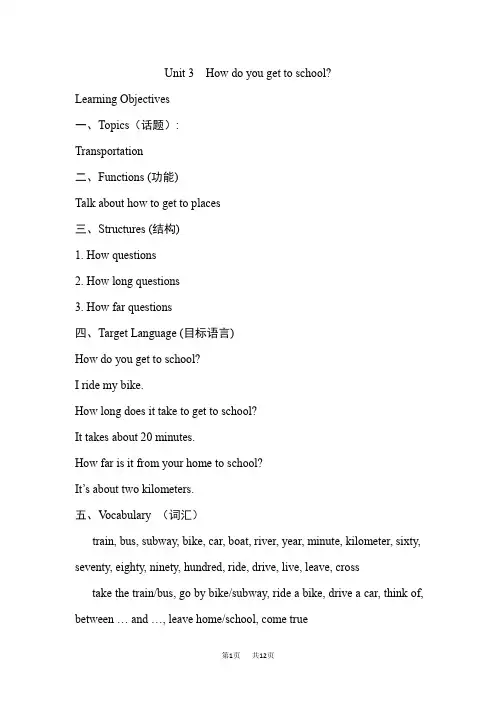
Unit 3 How do you get to school?Learning Objectives一、Topics(话题):Transportation二、Functions (功能)Talk about how to get to places三、Structures (结构)1. How questions2. How long questions3. How far questions四、Target Language (目标语言)How do you get to school?I ride my bike.How long does it take to get to school?It takes about 20 minutes.How far is it from your home to school?It’s about two kilometers.五、V ocabulary (词汇)train, bus, subway, bike, car, boat, river, year, minute, kilometer, sixty, seventy, eighty, ninety, hundred, ride, drive, live, leave, cross take the train/bus, go by bike/subway, ride a bike, drive a car, think of, between … and …, leave home/school, come true六、Skills (技能)Listening for key informationScanning in reading七、Recycling (复习巩固)Numbers 1–30I usually …It is easy to …Thanks for …八、教材分析本单元以How do you get to school?为中心话题,主要运用How long/How far 询问“去某地的交通方式、时间、距离”,简单描述路线。
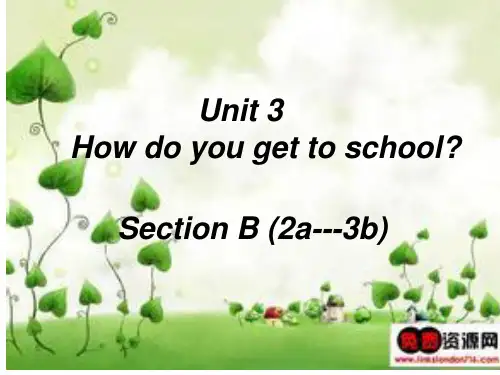
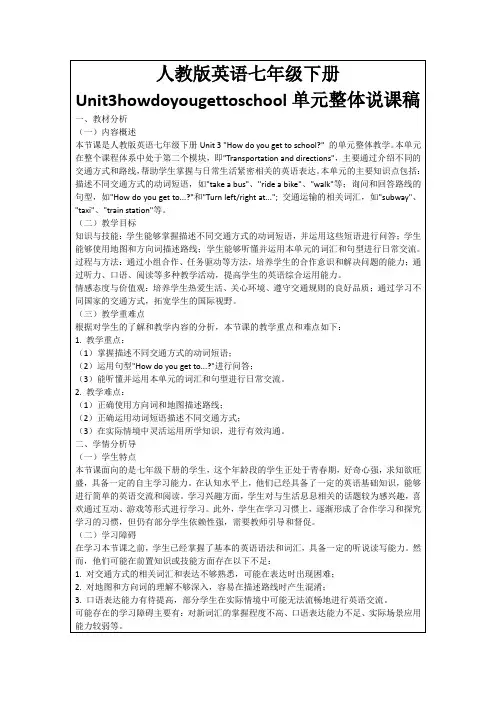
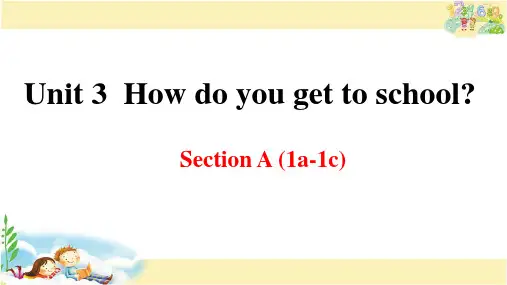

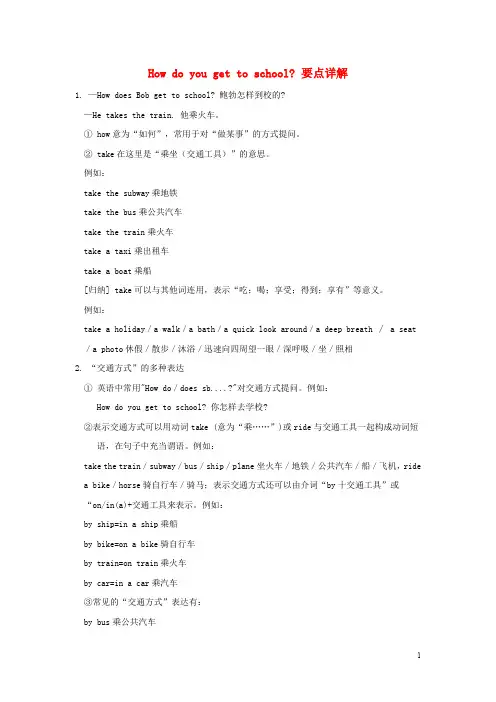
How do you get to school? 要点详解1. —How does Bob get to school? 鲍勃怎样到校的?—He takes the train. 他乘火车。
① how意为“如何”,常用于对“做某事”的方式提问。
② take在这里是“乘坐(交通工具)”的意思。
例如:take the subway乘地铁take the bus乘公共汽车take the train乘火车take a taxi乘出租车take a boat乘船[归纳] take可以与其他词连用,表示“吃;喝;享受;得到;享有”等意义。
例如:take a holiday/a walk/a bath/a quick look around/a deep breath ∕ a seat /a photo休假/散步/沐浴/迅速向四周望一眼/深呼吸/坐/照相2. “交通方式”的多种表达①英语中常用"How do/does sb....?"对交通方式提问。
例如:How do you get to school? 你怎样去学校?②表示交通方式可以用动词take (意为“乘……”)或ride与交通工具一起构成动词短语,在句子中充当谓语。
例如:take the train/subway/bus/ship/plane坐火车/地铁/公共汽车/船/飞机,ride a bike/horse骑自行车/骑马;表示交通方式还可以由介词“by十交通工具”或“on/in(a)+交通工具来表示。
例如:by ship=in a ship乘船by bike=on a bike骑自行车by train=on train乘火车by car=in a car乘汽车③常见的“交通方式”表达有:by bus乘公共汽车by train乘火车by ship/sea乘船by plane/air乘飞机by bike骑自行车by car乘小汽车on foot步行go to…by car=drive to…go to…by bike=ride to…go to…on foot=walk to…go to…by plane/air=fly to…3. It takes about forty minutes. 大约花费40分钟。
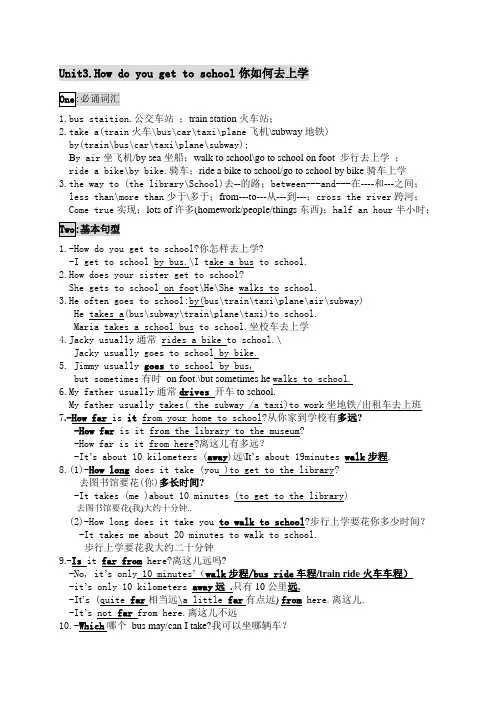
Unit3.How do you get to school你如何去上学1.bus staition.公交车站;train station火车站;2.take a(train火车\bus\car\taxi\plane飞机\subway地铁)by(train\bus\car\taxi\plane\subway);B y air坐飞机/by sea坐船;walk to school\go to school on foot 步行去上学;ride a bike\by bike.骑车;ride a bike to school/go to school by bike骑车上学3.the way to (the library\School)去--的路;between---and---在----和---之间;less than\more than少于\多于;from---to---从---到---;cross the river跨河;Come true实现;lots of许多(homework/people/things东西);half an hour半小时;1.-How do you get to school?你怎样去上学?-I get to school by bus.\I take a bus to school.2.How does your sister get to school?She gets to school on foot\He\She walks to school.3.He often goes to school:by(bus\train\taxi\plane\air\subway)He takes a(bus\subway\train\plane\taxi)to school.Maria takes a school bus to school.坐校车去上学4.Jacky usually通常 rides a bike to school.\Jacky usually goes to school by bike.5. Jimmy usually goes to school by bus,but sometimes有时on foot.\but sometimes he walks to school.6.My father usually通常drives 开车to school.My father usually takes( the subway /a taxi)to work坐地铁/出租车去上班7.-How far is it from your home to school?从你家到学校有多远?-How far is it from the library to the museum?-How far is it from here?离这儿有多远?-It’s about 10 kilometers (away)远\It’s about 19minutes walk步程.8.(1)-How long does it take (you )to get to the library?去图书馆要花(你)多长时间?-It takes (me )about 10 minutes (to get to the library)去图书馆要花(我)大约十分钟..(2)-How long does it take you to walk to school?步行上学要花你多少时间?-It takes me about 20 minutes to walk to school.步行上学要花我大约二十分钟9.-Is it far from here?离这儿远吗?-No, it’s only 10 minutes’(walk步程/bus ride车程/train ride火车车程)-it’s only 10 kilometers away远.只有10公里远.-I t’s (quite far相当远\a little far有点远) from here.离这儿.-It’s not far from here.离这儿不远10.-Which哪个bus may/can I take?我可以坐哪辆车?-You can take No.5 bus there.你可以做5路车去那儿。
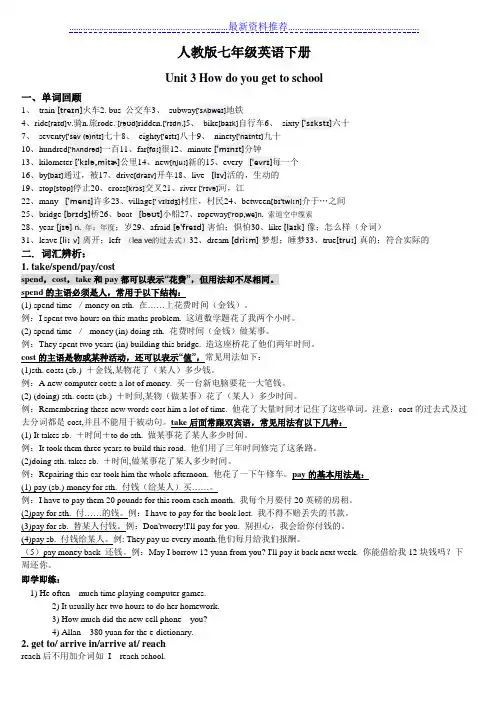
人教版七年级英语下册Unit 3 How do you get to school一、单词回顾1、train[treɪn]火车2. bus 公交车3、subway['sʌbweɪ]地铁4、ride[raɪd]v.骑n.旅rode. [rəʊd]ridden.['rɪdn.]5、bike[baɪk]自行车6、sixty['sɪkstɪ]六十7、seventy['sev (ə)ntɪ]七十8、eighty['eɪtɪ]八十9、ninety['naɪntɪ]九十10、hundred['hʌndrəd]一百11、far[fɑː]很12、minute['mɪnɪt]分钟13、kilometer['kɪlə,mitɚ]公里14、new[n juː]新的15、every ['evrɪ]每一个16、by[baɪ]通过,被17、drive[draɪv]开车18、live [lɪv]活的,生动的19、stop[stɒp]停止20、cross[krɔs]交叉21、river ['rɪvə]河,江22、many ['menɪ]许多23、village[' vɪlɪdʒ]村庄,村民24、between[bɪ'twiːn]介于…之间25、bridge[brɪdʒ]桥26、boat [bəʊt]小船27、ropeway['rop,we]n. 索道空中缆索28、year[jɪə]n. 年;年度;岁29、afraid[ə'freɪd]害怕;惧怕30、like [laɪk]像;怎么样(介词)31、leave [liː v]离开;left (lea ve的过去式)32、dream[driːm]梦想;睡梦33、true[truː]真的;符合实际的二. 词汇辨析:1. take/spend/pay/costspend,cost,take和pay都可以表示“花费”,但用法却不尽相同。
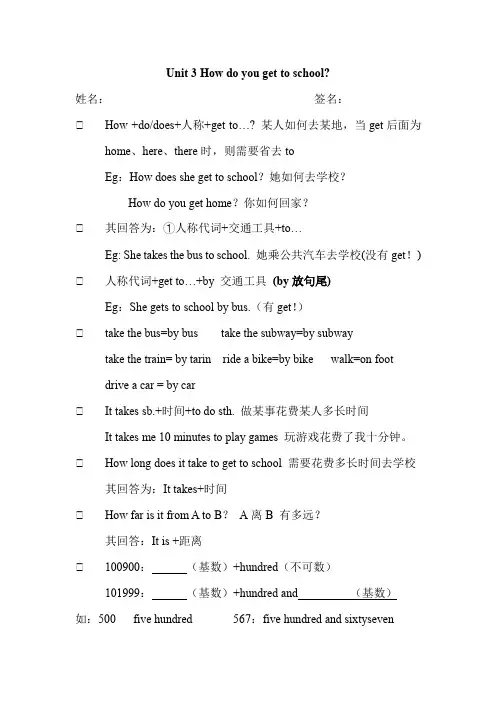
Unit 3 How do you get to school?姓名:签名:①How +do/does+人称+get to…? 某人如何去某地,当get后面为home、here、there时,则需要省去toEg:How does she get to school?她如何去学校?How do you get home?你如何回家?①其回答为:①人称代词+交通工具+to…Eg: She takes the bus to school. 她乘公共汽车去学校(没有get!)①人称代词+get to…+by 交通工具(by放句尾)Eg:She gets to school by bus.(有get!)①take the bus=by bus take the subway=by subwaytake the train= by tarin ride a bike=by bike walk=on footdrive a car = by car①It takes sb.+时间+to do sth. 做某事花费某人多长时间It takes me 10 minutes to play games 玩游戏花费了我十分钟。
①How long does it take to get to school 需要花费多长时间去学校其回答为:It takes+时间①How far is it from A to B?A离B 有多远?其回答:It is +距离①100900:(基数)+hundred(不可数)101999:(基数)+hundred and (基数)如:500 five hundred 567:five hundred and sixtyseven①hundreds of… 数百(+s)①It is good exercise. 它是一个不错的运动。
①Think of 认为;What do you think of+doing?你认为…怎么样?①For many students 对于很多学生来说①In one small village in China. 在中国的一个小村庄①The river runs too quickly 水流太快了①11yearold =11 years old(an eleven)①Between A and B 在A与B之间between you and me 在你和我之间①Be like =look like 看起来像①Dream e ture 梦想实现①be afraid of doing sth. =be afraid to do sth. 害怕做某事①too+adj. 太… too fun 太有趣了!so+adj. 如此…. So fun 如此有趣②①go on ropeway 坐索道②②leave the village 离开村庄②③at the bus stop在公共汽车站。
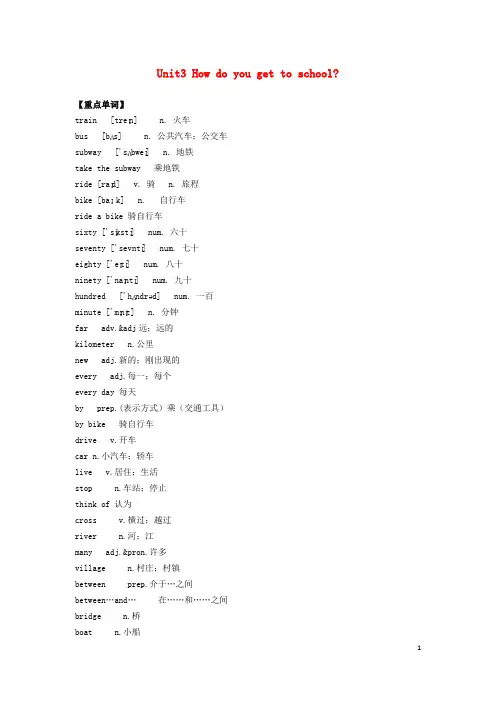
Unit3 How do you get to school?【重点单词】train [treɪn] n. 火车bus [bʌs] n. 公共汽车;公交车subway ['sʌbweɪ] n. 地铁take the subway 乘地铁ride [raɪd] v. 骑n. 旅程bike [baɪ k] n. 自行车ride a bike 骑自行车sixty ['sɪkstɪ] num. 六十seventy ['sevntɪ] num. 七十eighty ['eɪtɪ] num. 八十ninety ['naɪntɪ] num. 九十hundred ['hʌndrəd] num. 一百minute ['mɪnɪt] n. 分钟far adv.&adj远;远的kilometer n.公里new adj.新的;刚出现的every adj.每一;每个every day 每天by prep.(表示方式)乘(交通工具)by bike 骑自行车drive v.开车car n.小汽车;轿车live v.居住;生活stop n.车站;停止think of 认为cross v.横过;越过river n.河;江many adj.&pron.许多village n.村庄;村镇between prep.介于…之间between…and…在……和……之间bridge n.桥boat n.小船Ropeway n.索道year n.年;岁afraid adj.害怕;惧怕like prep.像;怎么样leave v.离开dream n.梦想;睡梦v.做梦true adj.真的;符合事实的come true 实现;成为现实【重点短语】1. get to school 到达学校2. take the train 乘火车3. take the subway 乘地铁4. ride a bike 骑自行车5. how do you get to school 怎么到达学校6. one hundred and five 1057. how far 多远8. how long 多长时间9. it takes sb some time to do sth 它花费某人多长时间做某事10. ride the bike to school 骑自行车到学校11. walk to , drive to ,fly to…步行去…;开车去…;坐飞机去….12. every day 每天13. I’m not sure 我不敢确信14. about= around 大约15. 10 kilometers 十公里16. good exercise 好的锻炼17. drive his car to work 开车去上班18. in his father’s car 坐父亲的车19. need about 10 minutes to get to school 需要十分钟的时间到达学校20. what do you think of…=how do you like…你觉得怎么样21. cross the river 过河22. It is easy to get to school. 到达学校很容易。
Unit 3 How do you get to school?知识点详解单元目标总览:【知识点详解】1、How do you get to school?(1)句子的结构是“How + do/does+主语+谓语+其他”。
当主语是第三人称单数时,助动词用does,其余人称用do。
◆How do you go home every day? 你每天怎么回家?◆How does your father get to work? 你爸爸怎么去上班?(2)特殊疑问词how 有“如何,怎样,多么”等意,用于询问动作执行的方式、手段、程度。
◆— How does your father go to work? 你父亲怎样去上班?— On foot. 步行。
◆— How do you like China? 你觉得中国怎么样?— Very much. 非常喜欢。
拓展:how可以和不同的词搭配,构成不同的意思来引导特殊疑问句, 除了我们之前学过的“how about, how many/ much, how old”等,常见的搭配还有:how far 用来询问距离,意为“多远”;how long用于询问时间的长短或者物体的长度,意为“多长/久”。
◆How far is it from your school to the cinema? 从你们学校到电影院有多远?◆How long is the river? 那条河有多长?2、take the train乘火车用“take + a/the + 交通工具名词”表示交通方式。
take a train乘火车take a bus乘公共汽车take a ship乘船take a plane乘飞机注意:“骑自行车”要翻译为“ride a bike”拓展:表示“乘……”的几种表达方式(1)用介词短语来表示交通方式,介词短语在句中作状语。
①用“by + 交通工具名词”表示交通方式。
unit3 How do you get to school教学设计
第一环节:新课导入
1.视频播放动画,并提出问题:How many kinds of transportation are there in the movie?〔设计意图:动画片激发学生兴趣,通过看动画片,学生巩固有关交通工具的单词。
〕
2.PPT出示图片:
〔师〕May Day is coming, I want to go to Shanghai. But how do I get to Shanghai? 〔师〕Now let’s play a guessing game. Listen the sound, then tell me what the transportation is?
〔设计意图:通过学生听声音辨交通工具,激发兴趣,活跃课堂, 为下一阶段学生要完成的交际性任务作好充分的知识储备。
通过前面话题的引入,来激活学生的知识图式,然后开始向学生输入本课的重点词组: take the train, take the ship, take the car, take the plane。
〕〔师〕Now Read and guess how I get to Shanghai?
1 ) It’s like a train but goes under the ground.
2 ) It has two wheels, you can ride it.
〔设计意图:听辨声音之后,采取猜谜语的方式再次学习新短语 take the subway, ride a bike/bicycle,引出本课的重点句型:How do you get to school?〕
3. 〔师〕How do you get to school?
〔实施过程:提问学生问题,how do you get to school? 让学生根据真实情况回答,同时拓宽知识点的应用,继续提问题:How do you get to Jinan/Dalian/Beijing?the park?〕
〔设计意图:由上一环节自然过渡到新课的学习,学生在不知不觉中感知新知识;多媒体采用形象生动的图片,保持学习新知识的兴趣。
教学内容与学生的实际生活密切相关,易于引发学生运用简单的英语进行交际和交流。
〕
4. 〔师〕Look at the picture. Make a list of how the students get to school in the morning. Then add other ways to get to school.
〔设计意图:学生通过做1a写出所有的交通方式来巩固所学,为下一步的听力奠定基础。
〕
第二环节:巩固练习
1. pairwork:
〔实施过程: pairwork,练习巩固。
然后学生展示对话。
〕
〔设计意图:学生在运用简单的英语进行交际和交流,并且学会关心他人,了解其他同学或朋友上学所采用的交通方式,再一次加强巩固所学。
〕
2. 做SA中1a,1b。
〔实施过程:学生通过听力,初步了解how does she/he get to school? 引出第三人称提问及回答的知识点。
〕
〔设计意图:通过配对练习,让学生再次熟悉如何使用某种交通工具的表达方式。
通过听力测试,学生不仅练习了听力,也初步了解了如何询问他/她乘坐交通工具的方式。
〕
3. Guessing game:
〔师〕Look at the screen, and guess How does he get to school? 〔实施过程: 男女生交替猜测,他/她去某地的交通方式。
猜对一方,奖励星星一颗。
〕 〔设计意图:游戏的方式复习了知识点,又活跃了气氛。
这个环节学生表现很积极。
〕
4. 〔师〕Listen and repeat. Then write the correct number next to the word.
〔实施过程:学生听并写下数字〕
〔设计意图:数字的表达方式,是之前已经学过的,通过这个环节,唤起学生的已知知识点,为下一个环节做好铺垫〕
5. 〔师〕Listen and complete the chart.
〔实施过程:学生听录音,并完成表格。
在学生听之前,教师讲解新的语法点:How long does it take?/ How far is it from …to …?〕
〔设计意图:通过此环节,既练习了听力,也对新知识点进行了讲解〕
6. 2d. pairwork
〔实施过程:Student A is Jane and Student B is Tom. Use the information in 2b to make conversations.〕
〔设计意图:通过pairwork ,学生对新知识点进行了演练〕
7. groupwork
〔实施过程:学生四人一组,进行口语操练〕
〔设计意图:通过groupwork ,学生对本单元的重点难点再次进行操练,熟悉用法,为下节课的学习做好铺垫〕
第三环节:情感渗透
1. 出示两张图片,一张为未污染的图片,一张为已污染的图片。
让学生感受地球正在遭受着污染,引出Our earth is crying.
How • A: ______ does Tom get to school?
• B: He ________________ _____ .
〔师〕Which picture do you like better?
2. 视频播放:呼吁低碳生活
〔设计意图:通过学习交通工具,让学生知道尾气对环境的破坏,呼吁学生及家长进行低碳生活,保护我们的家园。
〕
第四环节:家庭作业
〔师〕Make conversations with one of the pictures below
〔设计意图:此环节为巩固这节课所学内容,学习英语并应用到生活中去。
同时发现探索更多的表达方法。
〕。